
EDITORIAL
Foxgloves & Buttercups
Seekers
My friend Alex is tall, smart, and handsome. He's the sort of fella who gets chatted up all the time in the grocery store. You know, folks say things like "why, helllooo there, would you mind peaking up there to see if any toilet paper has been pushed to the back?" Yep, proper giant. And if you've spent some time around NSMB you'll probably know that, in addition to being tall, Alex owns a made in Canada fashion brand for tall people called NAVAS and a Geometron G1 that he purchased in September, 2020.
That date is important, because since I first met Alex in the summer of '97, I'm pretty sure this is the longest relationship he's had with a mountain bike. It's not that he's up and abandoned his bicycle-bachelorhood for some monogamous two-wheeling. I think it's fair to say he's always looking for his next fully suspended frame fling. It's just that companies are only now approaching the Nicolai-Porter geometry he loves and even then they're mostly not making proper long person bicycles. Even if they are, the chain stays are still usually much too short for a nicely balanced ride.
We often nerd out about new bicycles and Alex's boutique & badass German-made monster truck is regularly a frame of reference or a reminder that no matter how many brands have found their ways to the triathlon-steep saddle positions and WC DH slack head tube angles (HTA) there should be some recognition of how the concept was proven, and by whom. And that's my inspiration today. A year from now when we're talking about Buttercups, Foxgloves, Manitou's Elastomer Fluid Control (EFC) system, Zokes*, SR Duo Track, and every other company's trail 'noise-cancelling' 4mm-travel fork upgrade, I think it's important to recognize the little outfits that have been pushing versions of this concept for years, often faced with skepticism and derision from members of the riding community.
*Foxgloves with an 'M' stamped into them
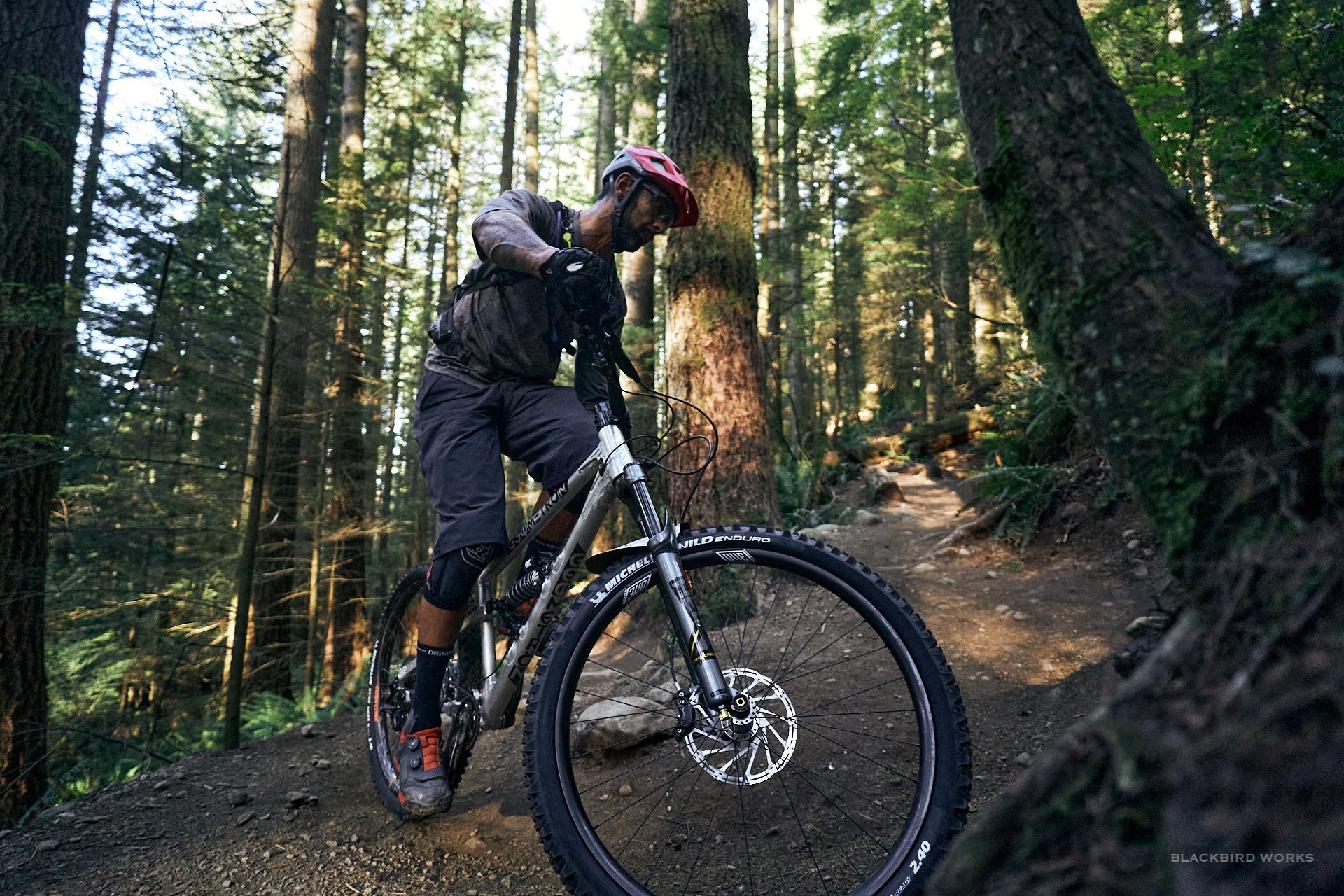
"My G1 is set up as a super aggressive climbable monster descender." Alex's XL G1 has a 535mm Reach, 452mm chain stays, and a 1330mm wheelbase. Photo: Deniz Merdano
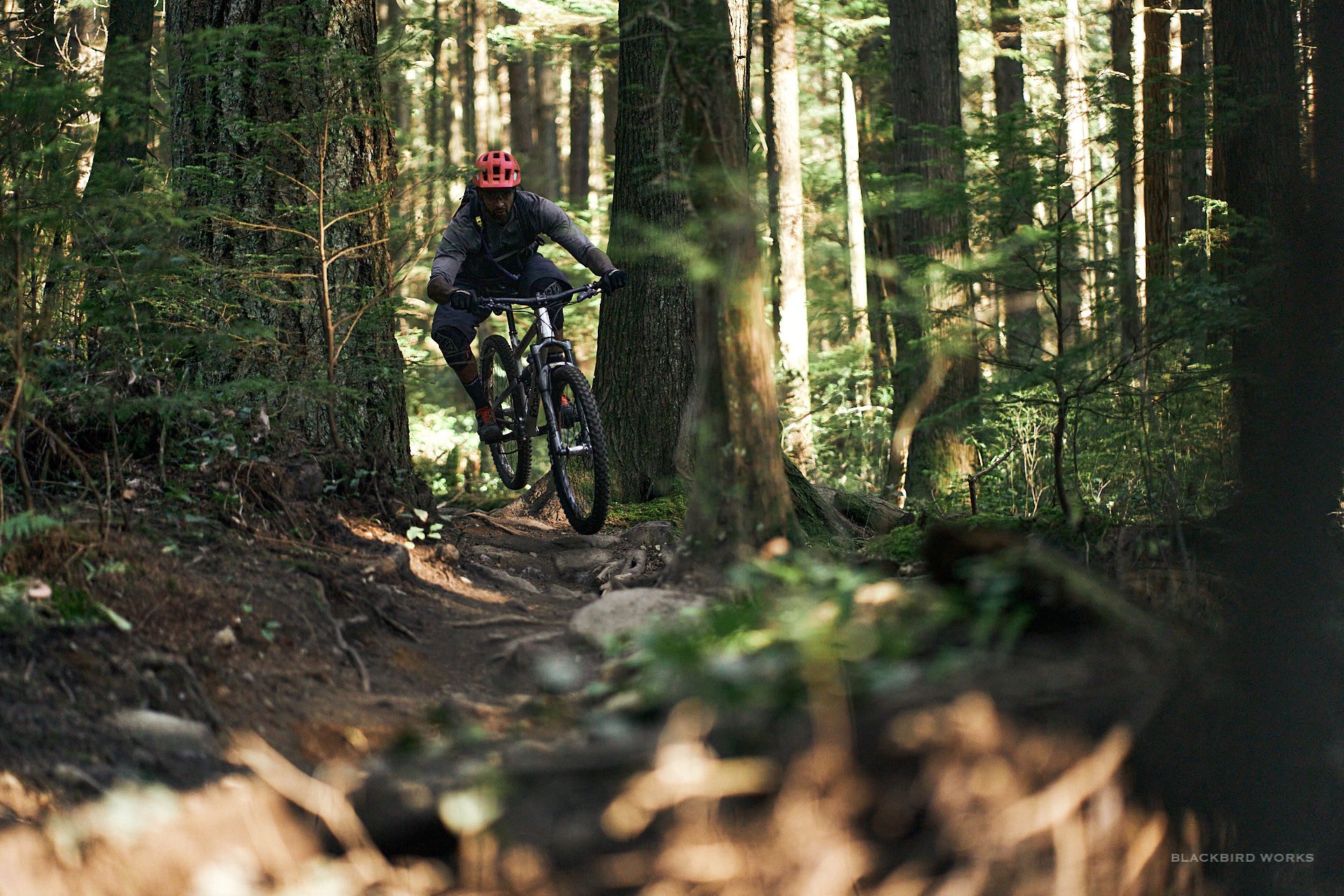
If you don't know Alex, you can check out the NSMB 'Getting To Know You' interview and check out his Geometron in the Dream Rides series. Photo: Deniz Merdano
The specific products I'm thinking about are Fasst Company's Flexx handlebars and suspension grips made by RevGrips. These products may not be something you need, but they are experience-changing for plenty of riders. I've been e-mailing with an NSMB reader named Phil about revisiting the Flexx bars, not from the perspective of someone who enjoys them (me) but from someone who needs them (him). He writes:
"I have a handful of holy shit moments on my bike yearly due to hand strength issues. Some of them result in me in the bushes, or broken ribs, or fantastic saves. I'm completely awestruck after trying this handlebar and I feel for my personal adaptive issues it will change my riding completely."
I've talked to a number of folks who have tried Rev's grips and were happy with the purchase, but then there are the folks who work with their hands for whom they're a revelation. And not just people whose suspension forks are three years overdue for their yearly service, but people with dialled in setups for whom Rev is the only system that prevents the dreaded 'claw' within a few turns. Stiffness, soreness, numbness, aching, whether you're typing or a technician, if your work is cruel to your hands to the extent that it affects your riding, these things make a big difference.
I don't think of these as suspension products in the sense of forks and shocks, but rather suspension assistance products. Counterintuitively, I find the Rev grips and Flexx bars are more notable on my full suspension bike, where I'm hitting stuff at much faster speed. That's especially the case with the bar.
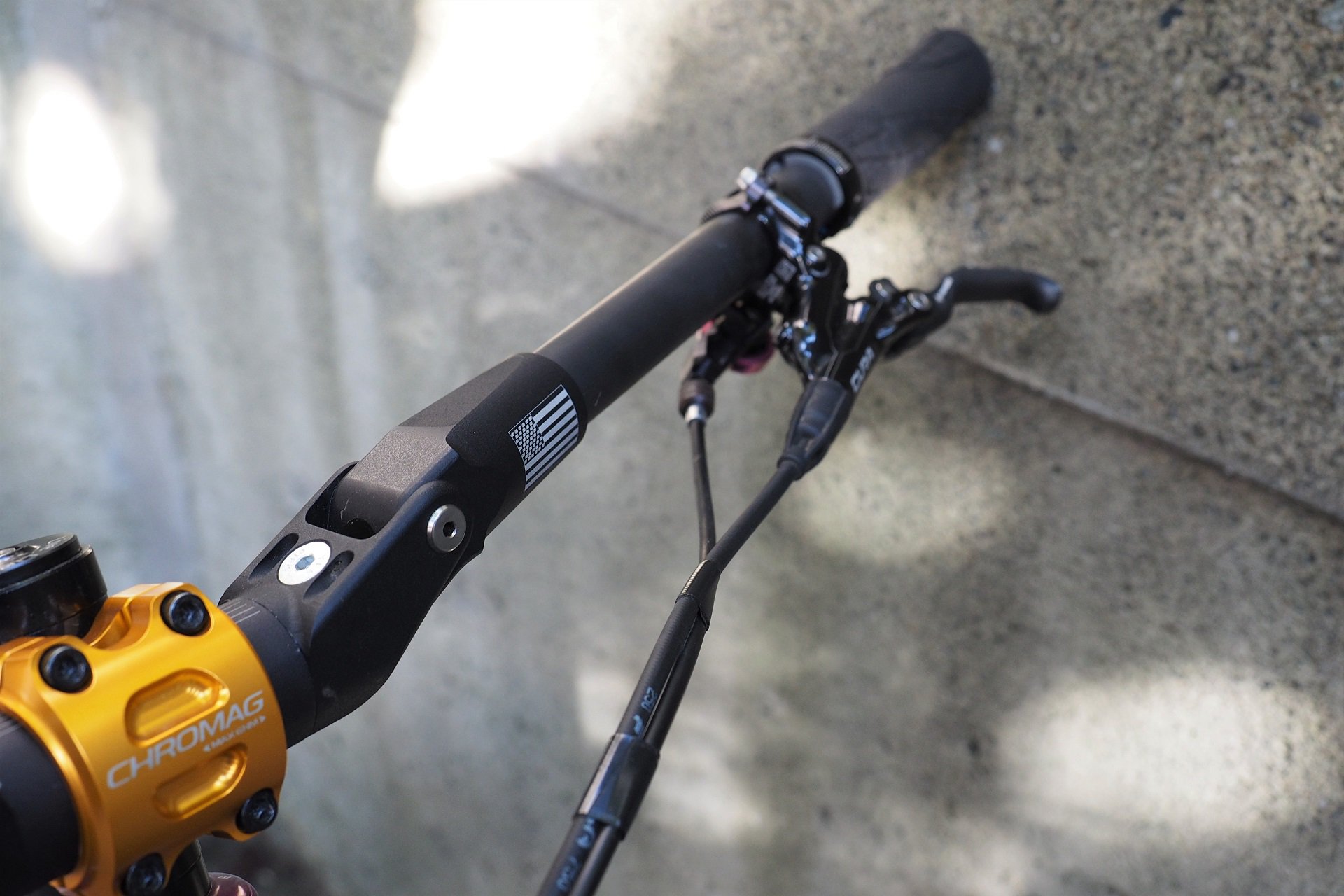
TheFasst Flexx suspension handlebar has 5° of travel out of the box at the full 800mm length. The idea is to dampen trail noise that your suspension fork doesn't soak up. When they're tuned perfectly they're unnoticeable while riding, but it's very notable when you're riding without them.
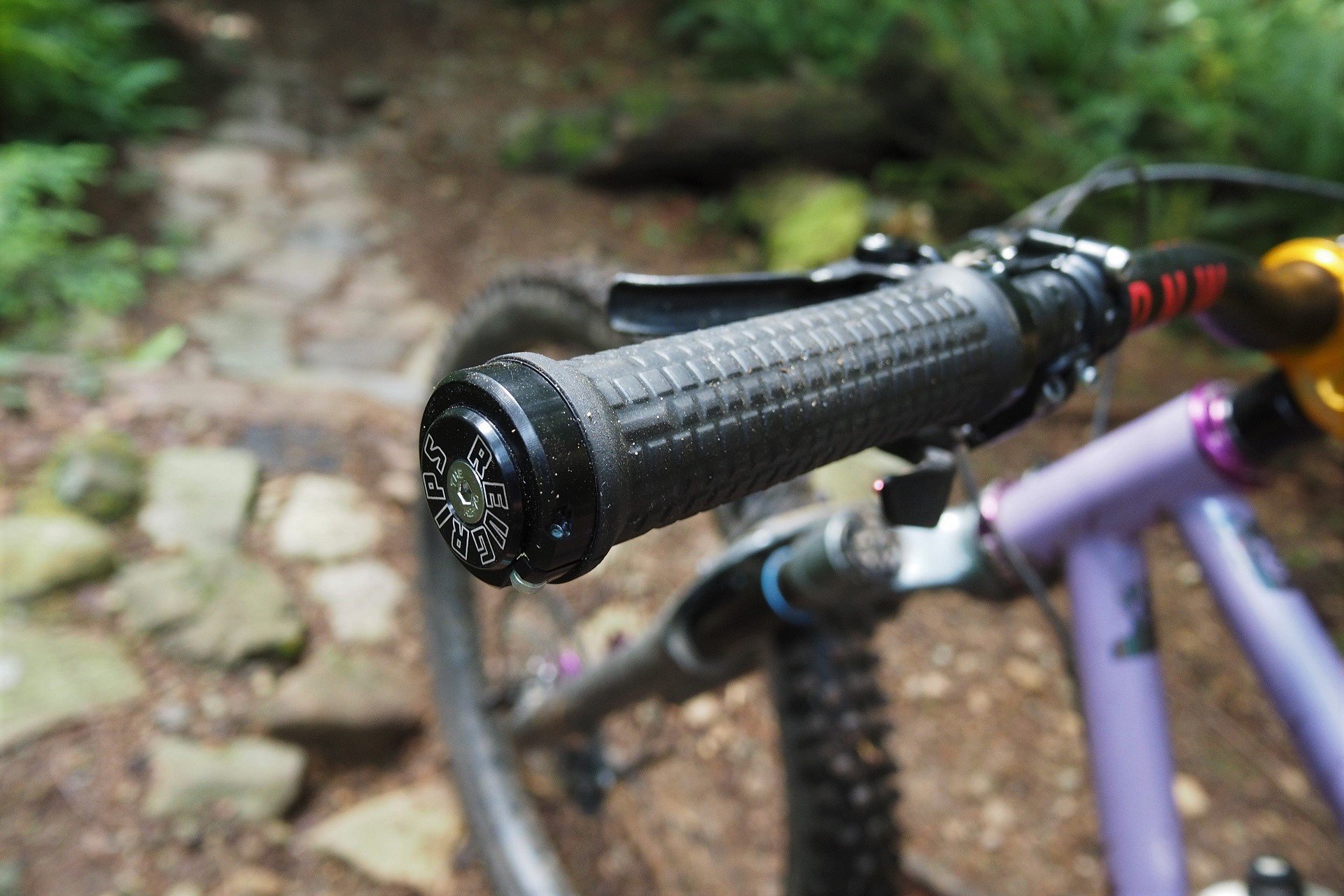
These Rev Race Grips are another elastomer-sprung trail damping product. They absolutely disappear when you're riding but the declaw factor is real if your hands are keeping you from riding as much, or as many laps as you'd like.
Going back to Alex for a moment, he regularly brings up a point about products that are engineered, or at least marketed, to perform in a certain way but only one version is made available. People come in a wide variety of sizes - weight, strength, weight distribution - so if you're hard-selling one version of a product that's supposed to add a performance benefit, shouldn't you also be providing some sort of information about the optimal rider for the performance benefit so that other riders can have some hope of calculating the percentage of the benefit they are likely to receive?
For a real world example, take the base model Rocky Mountain Growler 20 that I reviewed in 2020. The spec includes a basic SR Suntour suspension fork with a single rate coil spring. At a buck eighty five or so, I felt it was a little under sprung for my weight but it was firm enough, and the fixed rebound controlled enough, that it was an entirely rideable setup. If Rocky told me the fork was optimized for a 180lb rider hitting blue-rated trails then I'd believe them. I know folks sporting my same 5'9" stature that weigh under 150lbs and I know folks my height weighing in over 250lbs. The farther a rider sits from whatever median weight value the fork is set for, the less of the prescribed benefits they'll receive from the product. Fasst bars are an exception, shipping with a variety of elastomer spring rates. The Rev Race grips I reviewed are set at the most popular support level but there is also a Pro Series that has a wide degree of tunability.

Sneak peak inside the SRAM/RockShox factory. Maybe it's the weather, but Buttercups are showing up everywhere on the North Shore right now.
Successors
I have no idea what any brand is going to call their elastomeric vibration relief system other than RockShox's ButterCups system. It will seem like a shame if Manitou doesn't call their version EFC. If Fox had a sense of humour then Foxgloves would be doubly perfect. The lawyers at actual 'Fox Gloves' may take issue with that though. All the same, I have zero doubt that a similar system is coming from everyone. It's too easy and cheap to make to not offer it as a premium option. Or better yet, a standard feature through the whole lineup of performance forks. I am positive they'll all use elastomers* for this purpose as they're the lightest, simplest, quietest, and cheapest option for the application. My only wonder is if any forks on the market have the space in the lowers to offer such a system as a retrofit option or if, like ButterCups, this is for future forks only.
If you haven't checked out the RockShox ButterCups system, there's a full explanation in our MY23 Fork Teardown piece. I'm surprised they don't offer multiple rates for elastomers.** I suppose they may in the future. Or maybe changing them is enough of a pain - requiring the lowers to be dropped every time - and the spring rate, over 4mm of travel, covers most or even all riders. Either way, it would seem to this media hack that adding a degree of tunability via elastomer swaps or adjustability via preloading the elastomers will be an easy differentiator for one of their competitors' systems.
*Now that I've said that, some company (DVO?) will use coil springs instead of elastomers so the system won't be temperature sensitive or require replacements (elastic polymers harden over time).
** Chris Mandell from RockShox told us that ButterCups aren't tuned for rider weight. They are tuned for a frequency of vibration and are independent of rider weight.- Ed.
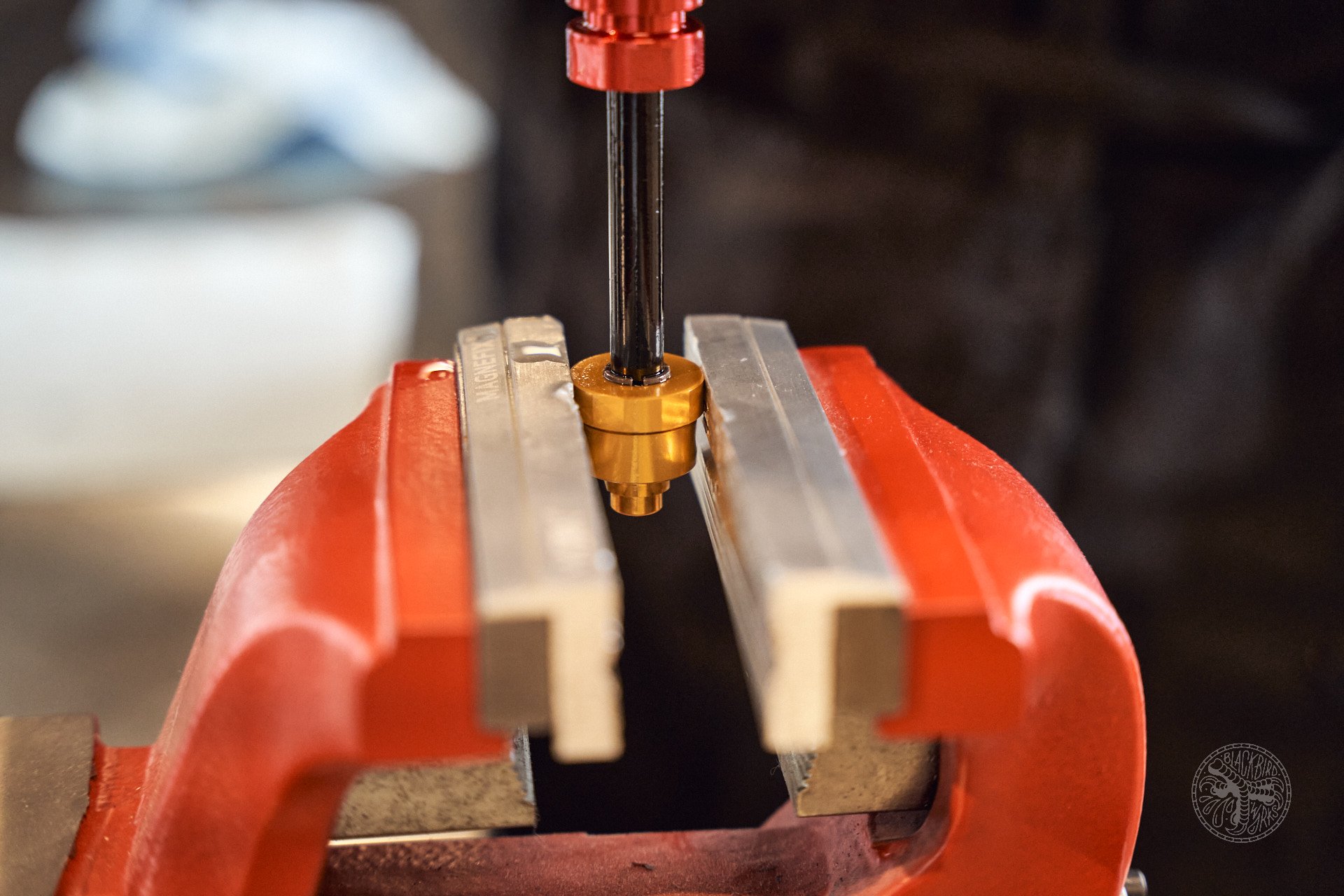
The system really only works as advertised if you have the a bumper on both sides. This is the damper side ButterCup. Photo: Deniz Merdano
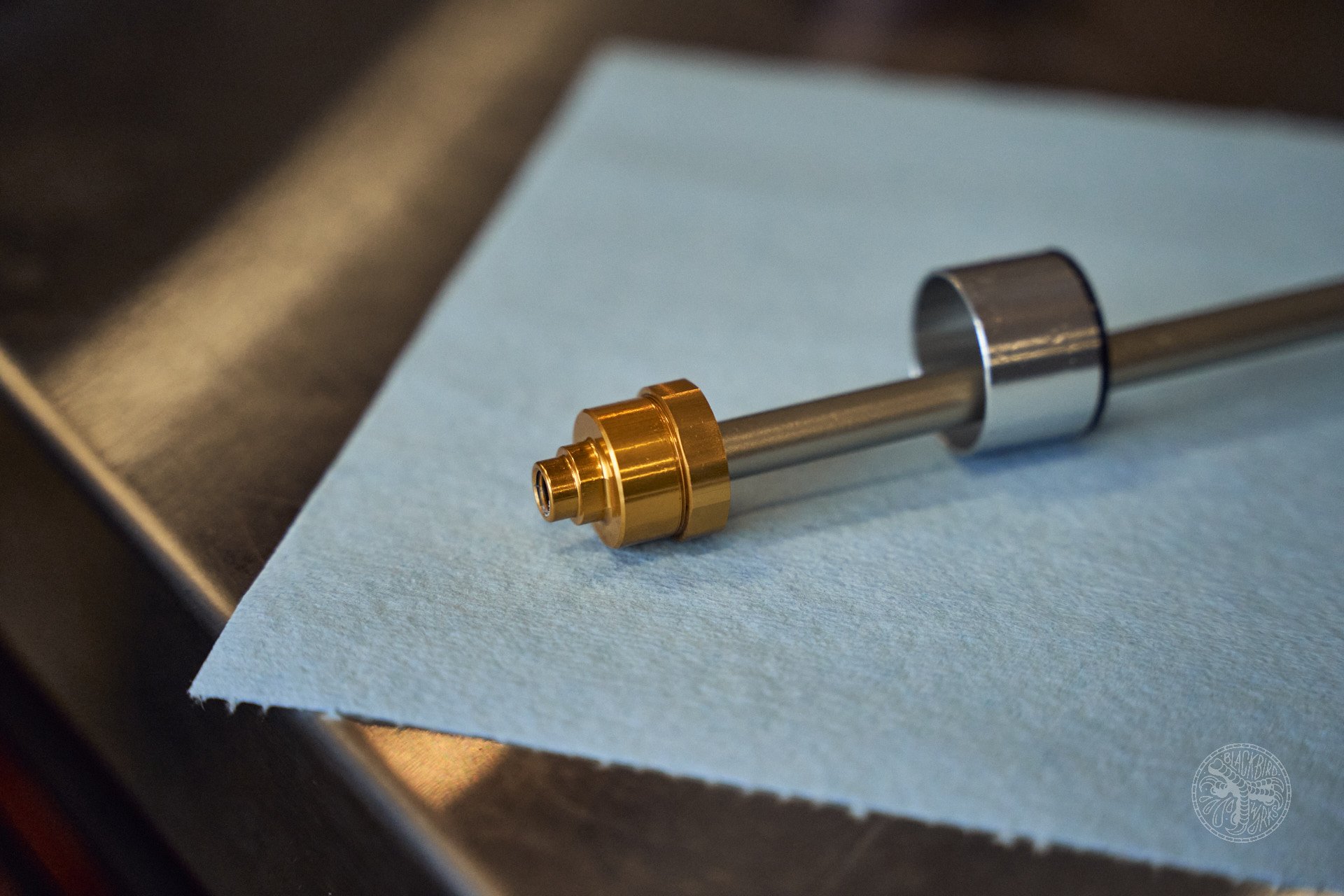
Here's the air side unit. The elastomer is contained within the anodized gold cup. They currently offer one spring rate. Photo: Deniz Merdano
I'm completely awestruck after trying this handlebar and I feel for my personal adaptive issues it will change my riding completely." - Phil
Elastomers are going to be everywhere in suspension in the next couple years. Expect most shock brands with coil shocks to spring out multiple sizes of tapered bumpers for their rear shocks - see Avalanche Racing bumpers for inspiration. Whether they were working on it before ButterCups dropped or not, expect every fork brand to have an elastomeric element for next year. Personally, from my experience with Fasst Flexx and RevGrips, I think this is a positive development, especially for the riders who greatly benefit from those two products. There will be some disappointed riders however, as the potential performance gains will be greatly overstated comparing a freshly-serviced fork with the few additional millimeters of elastomeric travel to a freshly-serviced fork without.
I highly doubt that any suspension brand releasing an elastomer suspension system for their fork will give credit to companies that came before them. I am certain that all suspension brands have ridden these bars and grips, and probably SRAM's ButterCups by now, too. But remember, if you're lamenting a lack of retrofit-ability with this new take on mountain biking's original suspension medium, if you duck the fashion police for a few minutes, you can get some portion of the benefits in a bar or grips without having to flip your fork for a fresh one. And be aware that a couple of little companies have been pushing the trail 'noise-cancelling' feature for a few years now.
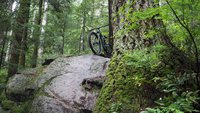
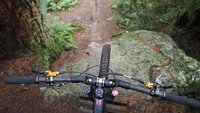

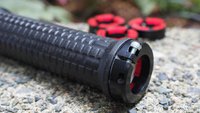







Comments
earle.b
1 year, 9 months ago
I forget if I had shared this in the initial comments on Buttercups.
https://www.agazzinibike.it/softride/
These guys have integrated elastomer into the shock mount in their rocker link. Buttercups for yer bum.
Pair this with trunion mount and it would take out some of the shock killing nature of trunion by allowing some lateral flex while also dealing with trail vibration.
RockShox 2024 with Buttercups integrated into the shock eyelets? If they are not working on it now, I'll take credit for it.
Reply
Andrew Major
1 year, 9 months ago
Like infinite-axis spherical bearings! Plus vibration damping. I think it’s a great idea.
But, like sphericals, it would leave no where for companies/frames to hide if they’re relying on the shock as a structural member for stiffness or alignment.
Reply
earle.b
1 year, 9 months ago
Sock for stiffness or structural is such a horrible idea.
Reply
Andrew Major
1 year, 9 months ago
Every shock manufacturer agrees.
Reply
Pnwpedal
1 year, 9 months ago
Bummercups?
Reply
mrbrett
1 year, 9 months ago
Bought Rev grips. It was more subtle than I was expecting. Back to soft/thick Deathgrips or slip-on Renthals for this guy.
Would be curious to see some back to back telemetry with buttercups/no buttercups. Surely one of the German sites will tackle this journalistic assignment?!
Reply
Andrew Major
1 year, 9 months ago
I run Chromag Wax grips and Sensus Swayze grips (push-ons) on my rigs currently. Can’t beat the value - performance v. price - as far as my hands are concerned and I enjoy installing them.
As with the Fasst bars, SQLab saddles, and other ergonomic stuff I’ve tested most of it isn’t experience changing for me - bars with more setback is the exception.
But, I’ve talked to so many people for whom these parts are ride altering, I think it’s important to keep bringing attention to them. I consider myself fortunate that you don’t ‘need’ RevGrips to help make riding sustainable.
I don’t know if ButterCups will be experience changing for some riders in the same way a Fasst Flexx bar is, but I’ve heard from enough folks for whom the bars were game changing that I truly hope it’s the case. At the same time I know enough folks that tried them and moved to something lighter & simpler that I don’t think ButterCups (and the like) will thrive on their performance alone.
———
*edit: preamble and other points I’ve made FS v. Rigid aside, if Fasst does end up doing a higher rise version of their bar I’d love to try it.
Reply
Deniz Merdano
1 year, 9 months ago
I can't say I'm fully sold on the rev grips either. They seem to do some damping but for some, loosing 5mm or so off the effective width of your bars will be an issue.
Buttercups however are real. Few rides on the new Pike and the fork is smoooooooth
Reply
Andrew Major
1 year, 9 months ago
New air system, new damper, fresh fork. I'm looking forward to reading some back-to-back reviews of the same forks, in the same condition, with and without ButterCups.
Most riders I know for whom RevGrips make a true experience difference for riding have no issue purchasing a new bar. I count myself lucky to be among those for whom they aren't experience changing.
Reply
fartymarty
1 year, 9 months ago
Deniz - coil smooth? One reason I like my Ohlins coils is they're super supple.
Reply
Deniz Merdano
1 year, 9 months ago
Back to back on a brand new factory 36 and Pike Ultimate and the difference was huge. This was on high-speed singletrack. Coil smooth? Probably pretty close
Reply
fartymarty
1 year, 9 months ago
Interesting. Back to back with a coil would be interesting.
Reply
Andrew Major
1 year, 9 months ago
The effort put into the new - more limited travel window - air springs and building IFP dampers without discernible crosstalk are, in theory, going to make a huge difference in initialization and how fluidly the system changes state from compressing to rebounding and vice versa.
It’s why I’d be so keen to see an Ultimate to Ultimate comparison (so you also get the increased bushing overlap) with just the ButterCups removed.
Andy Eunson
1 year, 9 months ago
Similar to my experience. I was having elbow issues so I thought it was worth a try. Well made and they do move like they say but it made no difference for me. I find that my hands fat pads or whatever they call that moved anyway.
For me it’s more about having a larger diameter. 33 or so is about right. Back before we had suspension or even tires bigger that a 2.1 small grips just pounded into your hands. I could never get used to that even though Tomac used them.
I do not remember the Girvin flex stem fondly so putting two on a bar gives me the willies. I’m sure you don’t get the amount of movement a flex stem had but still. So funny how we were told we want stiff, stiffer, more stiff, really stiff, stiff stiff st…compliance compliant compliance now. Make up your minds industry.
Reply
Andrew Major
1 year, 9 months ago
Did you ever try a bar with more backsweep? My elbow issues (both but mostly my left) had me rethinking rigid single speeding until I tried a 16° 30X. So, so much better now. The benefits were less notable when running a suspension fork but enough there as well that I default to a 12° or 16° bar.
Reply
Andy Eunson
1 year, 9 months ago
I was looking for that but I had 35mm stems at the time because that’s how my bikes came and I wasn’t able to locate any 35 bars with backsweep. Now I’ve retired all the 35mm stuff for 31.8 because there seems to be still more choices available for the (ahem) compliant sized bars. I did get down to a 740 width which I really like. I cut down my 35 bars when they needed to be retired and rode a month or two that way. Then bought new Chromag bars and stems on sale and went back to 760 for a bit before deciding that 740 was my size. No more elbow issues, except for this year but that’s related to shovelling or maybe using hiking poles.
Reply
Andrew Major
1 year, 9 months ago
I've been running much narrower bars (770mm or 760mm depending) the last couple of years as well. Running modern geometry I don't have any issues with steering or stability, though I do remember what a godsend my 800mm bar was on my 71° static HTA Niner!
Reply
Ripbro
1 year, 9 months ago
At a little under 140 lbs, I reshim all my forks. Had a DVO diamond, and it had way too much compression dampening for my weight. What’s the point of having HSC and LSC knobs when your forced yo run them wide open?
On a Mezzer now and again had to size down a shim. Stock would have been too firm.
Manitou has published some guides for forks that give shim stack suggestions. I wish more manufacturers would do the same.
I like how DVO and Manitou have good Technical documents for the do it yourselfer. It would be nice if all companies did this, or had drop in stacks that you could buy aftermarket
Reply
Andrew Major
1 year, 9 months ago
Yeah, Manitou has a very interesting culture that way. They're pro-DIY with good manuals (though I haven't seen anything on re-shimming current dampers) but at the same time not in a way where they're making their products super simplified. I mean, DIY friendly in terms of requiring the minimum number of proprietary tools and having an encouraging attitude about folks tackling stuff themselves.
Reply
Ripbro
1 year, 9 months ago
Not quite what’s used on the Mezzer expert but info on a vtt system
https://hayesbicycle.zendesk.com/hc/en-us/article_attachments/360056988533/VTT_Tuning_Guide.pdf
Reply
UFO
1 year, 9 months ago
Zokes (THE Zokes, not Marzocchi).... I hope you did not have the pleasure of riding one of these back in the day. Definitely at least 4mm extra lateral/radial/axial/all direction travel when the top caps backed themselves off and the stanchions started to loosen
Reply
Andrew Major
1 year, 9 months ago
I mean, Zokes were Marzocchi. Undamped low-end elastomer Marzocchi's but still the same brand. And yeah, hot garbage.
As far as top-end suspension forks have come, it's insane how much better the basic stuff is... even the SR Suntour I've been riding with a single coil spring rate and no damper adjustments at all (including rebound).
Reply
SomeBikeGuy
1 year, 9 months ago
I bet that some sales guys and a couple of engineers at some bike product companies are passing this article around this morning and that they're all using it to justify doing something colossally stupid like creating vibration damping carbon handlebars "a la One Up" that are produced in 3-5 different widths, all tuned for "max damping performance and steering precision" with, obviously, slightly different carbon layups for each width and with each width coming in 6-8 different colour/graphics options and at least 2 rise options per colour. "Roadies have to choose a bar width at the time of purchase, why shouldn't mountain bikers? Besides, we can tell them it's better and sell way more SKUs into shops in the process, even if it isn't better or the benefits are so marginal so as to be meaningless!" And all of this because some super tall, super skinny guy named Alex thought starting his own clothing company was a better idea than just finding a good tailor. Talk about unintended consequences...
All joking aside, I'd be willing to bet someone actual, real-life money that there are companies that will release different width handlebars within the same handlebar model, with some stupid and probably unworkable "technology" like "tuned carbon layups for each specific width" that you therefore shouldn't cut for width at all or your warranty is instantly voided, before the end of 2023.
Reply
Andrew Major
1 year, 9 months ago
There have been minimum widths for some bars for years - a decade for Easton*? - because if you cut them too narrow they don’t flex as intended.
———
*Easton MTB bars which are RaceFace now. Just looked and RaceFace doesn’t publish minimum widths.
Reply
Andrew Major
1 year, 9 months ago
OneUp lists a max trim width of 740mm, SQ 30X carbon can be cut to 720mm - just as examples.
Reply
Justin White
1 year, 9 months ago
Yeah, why not? Cutting an 800mm bar down to, say, 750mm is a decent chunk of leverage gone, the bar is definitely not going to act the same. Maybe not void warranty, but certainly recommend a minimum before trying a shorter length to begin with. I just cut 20mm off each side of a new Renthal bar for the 3rd or 4th time, so I know the bar width I want. I would love a specific 760 bar, or even something like a 775 that is just slightly softer than the 800 but firmer (and obviously longer) than the 750.
Reply
Cam McRae
1 year, 9 months ago
This is something that has annoyed me for some time. Those who need the flex the least get the best flex profile (because in general but not exclusively, larger and heavier riders need wider bars) . A cut bar that is less flexible under a lighter rider is an undesirable outcome.
Reply
Pnwpedal
1 year, 9 months ago
Weight specific bars could be an interesting market option. Or at least call out the tested rider weight in the specs if the bar's flex is a selling feature. Physics can't be denied that flexy handlebars for a taller 200lb rider at 820mm width are not flexy for a shorter 120lb rider at 740mm...
Reply
Timer
1 year, 9 months ago
Weight specific bars have been around for a long time, they are just labeled with "intended use".
Light riders can use a lighter, more flexible trail-rated bar for DH, or a XC rated bar on their trailbike.
Reply
Andrew Major
1 year, 9 months ago
I think Alex makes the important point though, which is some kind of rating system - however approximate- would be helpful.
Give it a stiffness number (like shoes) and then an idea of how much that increases when cut. For added bonus give a target rider weight range for said rating.
Not perfect but tools to help riders make the right purchase.
Cr4w
1 year, 9 months ago
Each bar should have a flex rating (Ie Sixc vs next r vs Atlas) and each cut mark should say the width and new flex rating at that width. It's not that hard. People can figure out their preferred flex rating as factored by their height, weight, riding style, etc and find the bar that offers the correct flex rating at their preferred width and rise.
It took a lot of trial and error to figure out that I like Next R best for general flex but the advice from different sized riders with different preferences was all but useless.
Reply
cheapondirt
1 year, 9 months ago
My moment of realization that I am in the target audience for noise cancelling products:
I was massaging my wife's back with the theragun and said, "I'd like to keep helping you with this but my wrists are killing me."
She said "Really? I can do it for a lot longer without feeling any pain."
Sign me up for a Duo Track, please!
Reply
Andrew Major
1 year, 9 months ago
It's always interesting talking to two folks with such different experiences with a product. Fasst Flexx bars are the ultimate example - which is why I quoted Phil is the article.
Reply
Justin White
1 year, 9 months ago
Pretty sure it's not 4mm "extra travel", just 4mm of elastomer action before the air spring and the damper.
Speaking of both legs, it's interesting they're claiming it's all frequency since the resonances of the damper and the spring are definitely going to be different, yet they get the same rubbers. And differing weights are definitely going to squish the elastomer differently and leave not exactly 4mm travel and that's going to change the frequency response, it can't really be completely weight independent.
Reply
Andrew Major
1 year, 9 months ago
I'll say from my experience with Fasst Flexx bars that the trail-noise canceling effect is certainly much greater than just a few extra millimeters of travel but also that the different rates they ship with the bars make for very different on-trail experiences (as someone who's technically between recommended spring rates).
I haven't ridden ButterCups. I've been told that on two fresh forks, same air spring, same damper, back-to-back I'd definitely notice the difference. Much more so than just a bit more suspension travel. Again, going off my FF experience I have no reason to believe that's not the case.
Reply
Justin White
1 year, 9 months ago
The fact that the Flexx bars come with different spring rates and they have a noticeable (to you at least) difference, that supports my thought that SRAM is full of it when claiming ButterCups is not rider [weight] dependent and all about trail frequency.
There is no "more suspension travel" with ButterCups, AFAIK, not sure why you keep making this comparison...
Reply
Andrew Major
1 year, 9 months ago
The rates are hugely varied from softest to firmest. There’s no way anyone who’s experimented with rates on a Fasst bar can’t feel the difference.
I’m between rates but in my experience it was better to go up a bit - this echoes most folks I’ve talked to whether they stuck with the bars or not.
———
According to RockShox the ButterCups add 4mm of additional vertical compliance.
In my mind this is like the 5* of movement in the Fasst system. It’s serving a different purpose from creating traction (damping trail-noise) but it’s still additional movement.
Reply
Justin White
1 year, 9 months ago
Just different movement in the forks, not additional. Compliance, not travel. They still have the same travel length options, so if the cups are adding travel, they took the same travel out of the spring, and/or didn't change the mechanical bottom-out for each length. I don't think that upgrading to ButterCups (if possible) won't change overall distance your hands can move relative to the front wheel, but, as you noted, adding the bars will.
Reply
Andrew Major
1 year, 9 months ago
This is from RockShox:
“These little ButterCups add about 4mm of vertical compliance to your suspension and an average of 20% reduction in trail chatter from reaching your hands. All of this happens whenever your bike is in motion.”
My understanding is that the lowers had to be redesigned to accommodate the system. Traditionally many forks have a few mm of stanchion proud of the seal at full bottom out, so I have no reason not to think it’s additional vertical movement. It’s +/-4mm, so not something I put any thought into previous to this conversation, but again something that would be interesting to consider in an apples:apples ButterCups v. no ButterCups comparison.
Justin White
1 year, 9 months ago
"so I have no reason not to think it’s additional vertical movement."
Because they would surely label the forks with a longer travel number and shout about it!
"New Zeb '170' with ButterCups now has 174mm at the same or less weight and with the same air spring you know and love from the previous Zeb!"
I have no reason to think a MY23 Zeb 170 with Cups has more travel (additional vertical movement) than a MY22 Zeb 170 (or MY23 170 without Cups).
Andrew Major
1 year, 9 months ago
Not sure what I can say at this point other than directly quoting RockShox.
cheapondirt
1 year, 9 months ago
I don't have a Zeb to measure, but there is no way RockShox subtracted 4mm from the rest of the system to still hit exactly 170mm of travel including buttercups. With memories of redesigning an airspring just so riders could see it fully extend while not riding, fresh in their minds... they know a fork marketed as 174mm but with only 170mm of *damped* travel would create an internet shitstorm.
Andrew Major
1 year, 9 months ago
@cheapondirt, anything is possible I guess, but from SRAM’s material (quoted) they’re clearly (to me) saying an additional ~4mm of vertical movement.
I guess if the forks still show apples:apples stanchion height/bottom out with the BC installed that wouldn’t be the case though. I don’t have a fork to measure but it shouldn’t be hard to confirm.
I don’t know if it makes a big difference if their 166mm+4mm or 170mm+4mm. Depending on how the BCs compress. For example, coil shocks don’t fully stroke with the bottom out bumper installed (it compress ~1/2) and no one complains.
BarryW
1 year, 9 months ago
Andrew, it clearly says 'compliance' not travel.
That's not a language error, they are using compliance s a different word than travel.
And we all now that compliance IS different. Like the compliance of the rails on a seat, or the padding even.
Justin seems correct on this one.
Andrew Major
1 year, 9 months ago
@BarryW, what is the difference? Unlike the other products you listed, SRAM quantify ‘compliance’ from the ButterCups with an amount of vertical movement. It’s about 4mm.
I included the text straight from RockShox in the comment you downvoted.
In this application ‘travel,’ or ‘compliance,’ or ‘telescoping,’ or ‘compression’ would all be synonymous. It’s a quantified amount of vertical movement.
So either the system travels X+4mm to full bottom out (which is how the marketing copy reads) or it travels X-4mm+ButterCups to full bottom out (which is what Justin is saying).
I’ve asked a couple folks to measure stanchions for me. It should be an easy question to answer. I’m not sure it matters either way beyond a general preference for accuracy.
Justin White
1 year, 9 months ago
Have to also remember that the "4mm of compliance" is both bump and droop since the Cups act in both directions, so it's not simply +4mm towards total travel , but +2mm and -2mm.
Max "extra travel" would be <= 2mm, so I suppose they could be just writing that off as a marginal gain (~1.1-1.3%) in travel and maybe just adding a little more room in the tolerances of the travel dimension (I can't find any tolerances for RockShox; Fox lists +/-5mm for axle-to-crown, but nothing for travel). The air shaft is different to fit the cups, so it makes sense to take an extra 1 or 2 mm off its length beyond the space for the Cups and not mess with the existing tolerances that are time proven.
Justin White
1 year, 9 months ago
I'd bet the Fox Head and Fox Tail lawyers are the same lawyers. If someone in Tail's marketing decides Foxgloves is "the name", the apparel company ain't gonna complain.
Reply
Andrew Major
1 year, 9 months ago
I think we can all agree that Fox Racing Shox is not cheeky enough to name their pending* product 'Foxgloves.' I mean, I'd love to be wrong. Oh, how I'd love to be wrong. I'd even donate my entire fee (I mean, I assume they'd want to compensate me for the idea?) to the local food bank.
*I'm ASS-U-ME-ing they have something coming out of the burrow. I don't actually have any insider knowledge that's the case.
Reply
Justin White
1 year, 9 months ago
They're cheeky enough (well, used to be just a few years ago) to put "Kashima"* on the outside of air-cans just to have more Kashima on display, so... "you're saying there's a chance"?
* (In quotes only because the golden coating on my DPX2's damper-body and air-can match each other but not the coating on any Fox forks I've seen. And the damper-body explicitly says Kashima on it, just like the forks. Weird.)
Reply
cxfahrer
1 year, 9 months ago
I don´t have positive associations with EFC forks and buttercups either. EFC fork in 1996, riding in the winter.
I have ranunculus repens in my garden, they overgrow and creep under everything, they are poisonous and they look like parsley before they blossom. I just hate them. To get rid of them, I would have to change out all the soil. It is an invasive species anyway.
So, generally spoken I dont have a positive attitude towards elastomer buttercups and any other similar products. They idea is not bad, though.
Like really long chainstays on a bike with 535 reach, to each their own. I think I would like 535 reach, but not with such long chainstays.
Reply
Andrew Major
1 year, 9 months ago
Hahaha, other than some Z1/Z2 nostalgia and just the ‘I was there’ factor who has any positive association with ‘90s suspension forks?
I don’t know if they’re as bad as patch pirating poisonous parsley though?!
Reply
Jakub Gábriš
1 year, 9 months ago
Buttercups as idea is great (and very obvious way of filtering small amplitude high frequency vibrations). The issue is, there is maybe one or two suspension fork manufacturers that consistently produce forks with good bushing tolerances (RS or fox aren't one of them), so any benefits are mitigated by stiction of the bushings. The only way to get the absolute most out of system like this (or any suspension fork in general) is to get the fork professionally servised and bushings burnished. Only then it makes sense to focus on stuff like buttercups or previously very popular upgrades like skf seals for everything even sag o rings lol. Expecting mass produced forks to hit those tolerances just right every time is not realistic (but customer has every right to expect perfection, current prices of top end forks are ridiculous).
Reply
Andrew Major
1 year, 9 months ago
I will say for MY23 the Ultimate level RS forks, which are the units that ship with ButterCups, have significantly more bushing overlap. RockShox is marketing this for the stiffness improvement but I assume the change (and stiffness increase) is to keep the fork much smoother when it’s telescoping under loads.
It’s interesting how many companies don’t offer the ability to replace bushings as part of servicing products (but rather would expect you to change lowers if the bushings need to be done). I’ve seen enough Fox bushings replaced and sized (particularly when changing uppers) that I think it’s a nice feature.
Reply
Jakub Gábriš
1 year, 9 months ago
While more overlap is always better, without getting the clearance right it still isn't going to help with micro oscillations that buttercups are supposed to filter. I know I know, it's easy for factory to design new lowers with bigger overlap, getting the tolerances consistently spot on is much harder and can be only fixed by giving the person that assembles the fork more time to do it (sometimes a lot more). And time is money, with QC we get from the big dogs that is not a realistic expectation, they cannot even assemble the air spring right 99%of the time. Two zebs I worked on were obviously too tight, my c1 boxxer lowers were much better, but they were still giving me a proper workout to push 35.1mm burnishing head through. Of course the fork now works better and for longer after service, that is also pretty good indicator of tight bushings in the first place. The fork works good after lower leg service but it deteriorates pretty quickly and even storing the bike vertically isn't enough for the oil to get back up above those too tight lower bushings after riding it for some time. Slotted bushings should help with that but it doesn't seem to be the case, but maybe without them it would be even worse, who knows.
Reply
Flatted-again
1 year, 9 months ago
“*Now that I've said that, some company (DVO?) will use coil springs instead of elastomers so the system won't be temperature sensitive or require replacements (elastic polymers harden over time).”
I’m pretty sure EXT and DT Swiss use a mini coil for initial travel, but I wouldn’t be surprised if it has a similar effect as the buttercups.
Reply
Jakub Gábriš
1 year, 9 months ago
Similar, but different, they use it so the lowers can move in relation to the csu before the stiction in the air spring is overcome. However, coil spring is nowhere near as good for vibration damping.
Reply
Andrew Major
1 year, 9 months ago
Just to clarify, I was being cheeky with the coil spring comment. Elastomer bumpers are clearly the best option here from an effectiveness, cost, and weight perspective.
Reply
Justin White
1 year, 9 months ago
Cost, yeah, others, I dunno. I wonder if a CounterMeasure style spring (a kind of flat-coil/wave-washer hybrid, where most of the force comes from the wave). Pretty light, and effective enough for them to use it in a bunch of shocks.
Reply
Andrew Major
1 year, 9 months ago
EXT doesn’t make any claims about trail-noise cancellation or vibration damping, only that they use the coil spring to help with a smoother initialization.
———
I haven’t seen a new-model DT Swiss fork in the flesh in years.
Reply
Flatted-again
1 year, 9 months ago
Ah, got it.
Reply
Timer
1 year, 9 months ago
They might not have to make any claims. If the fork initializes travel, the main damper engages and vibration damping ensues.
EXT is an engineering firm. Not a marketing department which also happens to employ some engineers.
Reply
Andrew Major
1 year, 9 months ago
Have you ridden the EXT and this is your experience or are you hypothesizing?
I think for any system (coil, elastomer, tuneable air bag) to work as ButterCups does you’d have to have a spring on the damper side as well.
I did not mention EXT in the article as I have set up a few and know some owners and the consensus among folks I’ve talked is they’re very much ‘race’ forks. Lots of “fastest lap ever / demands to be pushed.”
I have only ridden them in parking lots so don’t have personal trail experience to share.
Reply
Jakub Gábriš
1 year, 9 months ago
Not direct answer to the question above but there is one theory that says it's better to have damper in the left leg because it helps with vibrations coming from. A disc brake..regardless of what spring is doing. I would say that this might be a thing, but only if the damper is less likely to bind than the air spring under side loading (which is the case with most modern forks with tube in tube damper arrangement, not so much with my custom boxxer lol. So I have damper in the right leg and it will stay there for now. But polyurethane spring seat? Here I come!)
Reply
Bushpilot
1 year, 9 months ago
I bought Rev Grips pro and ran them on the softest setting. I didn't end up finding them any more comfortable than my trusty Renthal Ultra Tacky push on grips. End of day they may have been less comfortable (I was using the thinnest version of Rev Grips) than the Renthal push on grips so the Rev Grips have come off and the Renthal's have been spray painted and wired back on.
I wonder if many of the people for whom Rev Grips are a revelation tried them straight from regular lock on grips. I can see how they'd be a big improvement from a comfort / the claw perspective over most regular lock on grips but I'd definitely suggest that those who struggle with hand pain try push on grips before springing for Rev Grips. Might save a pile of money and find a product that, for me at least, is superior. Win / win.
Reply
Andrew Major
1 year, 9 months ago
I’ve talked to people who’ve tried anything & everything to resolve hand-related issues while riding for whom RevGrips were the answer, so I think they’re always worth bringing up as a potential solution.
I don’t doubt that there are folks who jumped straight from standard lock-ons to lock-on RevGrips and so their results are missing a key option (despite my best efforts most my friends won’t try push-on grips, so my evidence says this is probably often the case). I agree that trying push-on grips first is the potential min-max win.
Reply
Bushpilot
1 year, 9 months ago
My Rev Grips experience might have been a fail because I like really thin grips and find I get hand pain from most grips with diameter over 30mm or 31mm. I think the smallest Rev Grips version is still a good 2mm bigger than the Renthal grips so that may explain my experience.
A big thank you to you though for those push on articles a ways back...that's how I got on to the Renthal push ons and I don't think I'll be going with anything else in the future. I have about 5 spare packages in my parts bin just in case I can't find them.
Reply
Andrew Major
1 year, 9 months ago
I had started working on a very off-brand piece on optimizing products (standards be damned) and Rev is probably a great example.
If they made their own bars as unrealistic as it is (different widths, rises, sweeps) the grip area could be much narrower than 22.2 which would give them room for the suspension system, thicker rubber, and a narrower overall size.
Reply
Andrew Major
1 year, 9 months ago
Hahaha, we have a few spare sets of push-ons at home too. They’re such a comparative bargain it always makes sense to amortize a trip or shipping (most local shops don’t stock push-ons either? Miss you 3Ride - loved those same-day Eclat Pulsar and ODI Longneck grips).
Actually, I have bought in-stick Sensus Swayze push-on grips from Obsession a couple times too (thanks Lou!).
I always preferred the thinner options - add Renthal to the above - but lately the Chromag Wax have been doing it for me.
Reply
Timer
1 year, 9 months ago
Regular lock-on grips have improved a lot in recent years, with some of them now rivaling push ons in terms of comfort and damping. E.g. Ergon, OneUp, ODI Elite Pro, SQlab. They use tricks like off-center bar position or cutouts in the inner shell to put as much rubber as possible between the hands and bars.
Reply
Andrew Major
1 year, 9 months ago
That’s very much a statement deserving a YMMV clause.
Certainly many lock on grips are much improved over the old dual-clamp Rogue & Ruffian - at the significant cost of poor durability in some cases - but I’ve yet to try anything that truly rivalled good push-on grips in my experience.
Further, most of those options are 2x, 3x, or even more expensive compared to good push-ons.
———
That said, I usually recommend PNW or OneUp lock-on grips to folks who’ve “never had a problem with their [read: double clamp] lock-ons in the past” and almost always get a “wow, these are much better.” They’re good grips and faff-free to install.
I like the Ergon options as well. But they’re a lot of money and I’ve come across a ton of broken ones. And people tend to break the same side (crash to the same side) so with the specificity you can’t even reliably make sets from the un-broken ones.
Reply
Timer
1 year, 9 months ago
As always, grips are highly personal. My main point was, that the comfort gap between push ons and lock ons is much smaller than it used to be.
I tried many options, because i'm quite sensitive to clawing up. To my hands, it feels like the best lock on grips come close to push ons. With some caveats. E.g. very thin lockons can't compete with very thin push ons.
Reply
Pnwpedal
1 year, 9 months ago
Buttercups... No thanks. Seems that Sram just added some initial undamped travel to mask too-harsh high-speed damping.
I have longer fingers so I've always ran thicker grips, which have some inherent vibration damping. Someone can always give ESI Chunky grips a try for less than $20. I'm a fan of the Oury single clamp grips from Lizard Skins these days.
I also notice a difference switching between a Chromag aluminum handlebar and an Ibis carbon fiber bar. There is some subtle vibration/chatter muting from the bar that I like.
One place that I still need to figure out some vibration damping is at my pedals. It's bad on a hardtail of course, but even on a squishy bike my feet feel sore after a long chattery high speed trail. New 5.10 Impact pro shoes kinda help, but I'm hard on pedals so plastics aren't the greatest option for me.....
Reply
Jakub Gábriš
1 year, 9 months ago
You need to rethink that, you are contradicting yourself there a bit lol. I guess you ride everywhere in the race car too right? Rose joints everywhere ftw!
Reply
Pnwpedal
1 year, 9 months ago
I probably am a bit, between praising compliance in certain parts but not wanting excess uncontrolled compliance in my suspension. My main gripe is that Rockshox initial high speed damping is rarely the most supple and adding a dollar of rubber bumpers only masks that harsh damping. I doubt Fox would try implementing a gimmick like this because they don't need to...
Reply
Andrew Major
1 year, 9 months ago
The my23 forks with ButterCups also have the new open bath damper and the new air spring. By all accounts they’re much smoother off the top.
If anything, I wonder if too much credit is being given to ButterCups.
———
I don’t have any money riding on it (or any inside track). But, I will be surprised if Fox and ~ everyone else don’t have a similar update coming. I mean, hence this piece.
Reply
Andrew Major
1 year, 9 months ago
That said, as more than a few of my friends have noted, the very best thing about MY23 RockShox is that the MY22 stuff is all on sale, in season. Lots of great deals to be had.
Reply
Jakub Gábriš
1 year, 9 months ago
They certainly don't have open bath damper Andrew, it's still closed cartridge just with ifp instead of bladder. No current fork uses open bath in stock form, and as far as I can think of, only ava offers open bath conversions.
Reply
Andrew Major
1 year, 9 months ago
Yes, thank you for this clarification. I meant to say an IFP.
Haven’t ridden an Avalanche damper for ages but I lived mine on a fully worked 2012 Float 34. Would definitely consider one if I already had a good chassis they support and was seeking an upgrade.
Velocipedestrian
1 year, 9 months ago
Maybe you're a candidate for the Catalyst pedals?
Reply
Pnwpedal
1 year, 9 months ago
Interesting..... Gotta do some research on those.
Reply
Andrew Major
1 year, 9 months ago
I've been going back and forth on the idea of these as part of managing my Achilles recovery. I could definitely use some extra support even just with the very-light trail riding I'm doing.
Reply
Velocipedestrian
1 year, 9 months ago
I'd like to read a typically thorough Drew-review.
Reply
Andrew Major
1 year, 9 months ago
Thank you. They’re 16mm longer than my current flat pedals. Every bit helps right now support wise as I try to build up the calf muscle again.
Reply
Andeh
1 year, 9 months ago
I was actually thinking a lot about vibration absorption yesterday, before reading this article, after a day trip to Northstar bike park this weekend. My biggest difficulty with riding the whole day there was that on most trails, there's a kind of resonant high frequency vibration from the brake bumps that is so small and fast that my fork can't absorb it. The whole bars end up vibrating so much it becomes difficult to hold on.
Now, I'm riding a high end bike with a lot of blingy bits that already take care of a lot of this. I've got an EXT Storia for the rear, and coupled with an O-Chain, my feet actually felt amazing and had very little fatigue. I was running an EXT Era fork up front, with the HSC all the way open and the rebound a bit faster than suggested, OneUp handlebars, Tubolight HD inserts in DH/DD casings, and RevGrips with the softest inserts. I wasn't getting any hand pain, just had a hard time holding onto the bars through the vibrations.
I'm not entirely sure that something like the FasstFlexx bars would help. It kind of seemed like the vibration was coming from the high speed brake bumps in such a way that the fork was flexing forward/backward rather than up/down. The bars seemed to be moving forward/backward in my hands more than up/down.
Anyways, for this particular vibration, I'm not sure there really is a technical solution, and it might just be that I need to improve my grip strength (more pushups and pullups).
Reply
Pnwpedal
1 year, 9 months ago
Did you ride the same setup and terrain with and without the O-chain? I'm always curious to hear real world experience about that system.
Reply
Andeh
1 year, 9 months ago
I've had it for over a month now, lots of riding on my local trails that I'm very familiar with. It was very noticeable right from the start (like within 30sec of descending). The rear end is remarkably calmer on small bumps, providing much less feedback to my feet. I run flat pedals, the default 6 degree elastomer, and have a frame with a pretty high level of pedal kickback (like 13 degrees).
One of my friends got one too after my experiences (he'd been looking at getting one without knowing I was too), and he noticed the same things on a different frame also with lots of pedal kick.
Only downsides as far as I'm concerned are cost, weight (if you care about that), and techy climbing ability - ratcheting is harder (I personally don't need this).
Reply
Pnwpedal
1 year, 9 months ago
Oh and for grip strength, the hand squeeze exercisers are always good. I just grabbed my gripprotrainer from the desk drawer to squeeze a bit.
Reply
Andy Eunson
1 year, 9 months ago
I did that for years but we called it winter riding the north shore with cantilever "brakes" .
Reply
hotlapz
1 year, 9 months ago
If you guys are on fox forks with evol springs, give the vorsprung luftkappe a try. It's cheap and it made my fork way better than I could imagine.
Reply
Please log in to leave a comment.